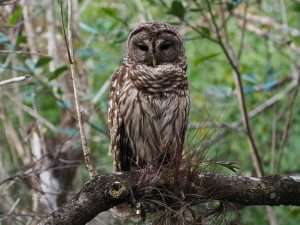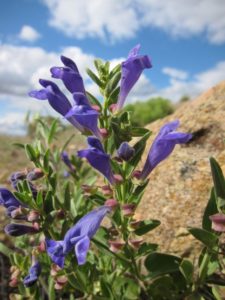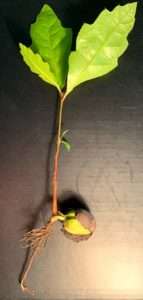 Look at any list of “things you can do to save the planet/combat climate change/prevent extinction/etc.”, and you’re almost always going to see “plant trees” as one of the suggestions. And why not? It’s a relatively simple act, especially if you have the space to do so; some conservation groups even offer young trees for free or as a fundraiser. It’s also a popular activity for volunteers. As someone who has been both a volunteer and a volunteer coordinator, I’ve found that planting trees, especially native species, is one of the easiest tasks to get help with. And a single tree is easier for most folks to take care of than an entire garden full of native species. Plus if you choose a tree that supports many native insect species, you could be creating an important microhabitat for pollinators and more.
Look at any list of “things you can do to save the planet/combat climate change/prevent extinction/etc.”, and you’re almost always going to see “plant trees” as one of the suggestions. And why not? It’s a relatively simple act, especially if you have the space to do so; some conservation groups even offer young trees for free or as a fundraiser. It’s also a popular activity for volunteers. As someone who has been both a volunteer and a volunteer coordinator, I’ve found that planting trees, especially native species, is one of the easiest tasks to get help with. And a single tree is easier for most folks to take care of than an entire garden full of native species. Plus if you choose a tree that supports many native insect species, you could be creating an important microhabitat for pollinators and more.
But is planting trees always the appropriate answer to every habitat question? Not necessarily. Let’s look at a situation where it may cause more harm than good.
Case Study: The Barred Owl
Hang around me long enough, and eventually I’m going to treat you to a rant about invasive species. (I consider it one of my more endearing traits.) Most invasive plant and animal species in the U.S. originated from other continents; however, it’s the natural boundaries that are more important than the human-derived ones. It’s entirely possible for a species from one part of a country to be an invader in another part, especially in a country as large and with as many varied biomes as this one.

The barred owl (Strix varia) is a good example. Native to the eastern half of the U.S., it was prevented from moving westward by the lack of trees on the Great Plains. It wasn’t until about a century ago, when settlements turned to towns, cities, and suburbs, that there were enough patches of trees planted to allow this species to hopscotch across the prairie to the forested Rockies and beyond.
Barred owls are now found in increasing numbers in forested areas of the Pacific Northwest, and their range is expanding. This is having a detrimental effect on the smaller northern spotted owl (Strix occidentalis). Both species occupy a similar ecological niche, but because the barred owls are larger and more aggressive they are able to out-compete the spotted owls. Moreover, spotted owls are more dependent on old-growth forests, of which only fragments have been saved from over a century of intensive logging. So while barred owls can live in just about any place with enough trees, spotted owls are being pushed out of the last remnants of their more specialized–and rarer–habitat.
The barred owls are only here because humans changed the Great Plains enough through tree planting. But there weren’t originally nearly as many trees in this grassland.
When Planting Grass is Better than Planting Trees
Creating a forest where there were none before is called afforestation, while planting trees where the previous ones were cut down or otherwise lost is reforestation. On the surface it seems like a great idea. After all, trees are excellent carbon sinks (and they get better at it the older they are).
But as the barred owl demonstrates, sometimes planting trees in new places does more harm than good. And many of the ecosystems that don’t have many, if any, trees are at least as threatened as forests, if not moreso. Grasslands, such as savannas and prairies, are among the most threatened ecosystems in the world; in the United States, over half of our native prairies have been destroyed, and millions of acres are being lost to agriculture and development every year. Grasslands don’t have the popularity of forests; Smokey Bear doesn’t have, for example, a Polly Prairie Chicken counterpart exhorting people to protect the tallgrass plains.
“But we were told planting trees was a really good solution to lots of environmental problems!” you may be thinking. And you’re right! In places where trees already grow naturally, planting native species helps increase habitat for many other species, prevents soil erosion, and contributes to long-term carbon sequestration.
But in grasslands, it’s the grass that plays this keystone species role. While some grasslands, like the oak savannas found in the Willamette Valley, do have trees scattered here and there, the big difference between a forest and a grassland is that the dominant plant is, well, grass! The other species there have adapted to living around various native grasses; animals find shelter and food there, non-grass plants find space to grow next to their Poaceae neighbors, and soil fungi develop mycorrhizal relationships with the grass’ roots. Moreover, native grasses are excellent at preventing erosion, and their extensive root systems may be even better at carbon sequestration than trees. (Healthy soil that hasn’t been destroyed by agriculture is also a huge carbon sink!)

All of which means it’s incredibly important for you to familiarize yourself with the native ecosystems found in your area, especially any place where you plan to engage in planting trees and other habitat restoration. Whether the soil you stand on was once a grassland, wetland, desert or forest, by researching the plant community that was there before you can help bring back a piece of what was lost. If you aren’t sure how to find that out, try contacting your soil and water conservation district, county extension office, or department of natural resources. Other entities to consider contacting include federal and state public land officials (especially biologists); college and university biology, ecology, and other natural history departments; and local or regional environmental conservation groups, such as your state’s (or Canadian Province’s) Native Plant Society. If you’re still having trouble finding someone to help, you’re welcome to contact me and I’ll be happy to see if I know of any resources you haven’t tried yet.
The Takeaway
 So does this mean you should never, ever plant a tree in a place that historically didn’t have them, even if it’s a species native to that region? Of course not. I don’t want to discourage people who are just trying to do their part to help with habitat restoration, and not everyone is going to want to complicate things as much as I do. If you want to plant a native (to your general area, if not your exact location) tree in your yard as a way to help, go for it.
So does this mean you should never, ever plant a tree in a place that historically didn’t have them, even if it’s a species native to that region? Of course not. I don’t want to discourage people who are just trying to do their part to help with habitat restoration, and not everyone is going to want to complicate things as much as I do. If you want to plant a native (to your general area, if not your exact location) tree in your yard as a way to help, go for it.
But the bigger ecological picture is something to consider if you have the luxury of time, space, and other resources to really plan out your choices in native plants. An ecosystem is made of much more than trees, and sometimes the trees aren’t even in the picture!

